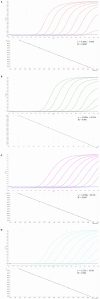Development of a TaqMan-based multiplex real-time PCR for simultaneous detection of four feline diarrhea-associated viruses
- PMID: 36406081
- PMCID: PMC9669448
- DOI: 10.3389/fvets.2022.1005759
Development of a TaqMan-based multiplex real-time PCR for simultaneous detection of four feline diarrhea-associated viruses
Abstract
Since their recent discovery, the prevalence of novel feline enteric viruses, including feline bocavirus 1 (FBoV-1), feline astrovirus (FeAstV), and feline kobuvirus (FeKoV), has been reported in China. Co-infections of these viruses with feline parvovirus (FPV) are common causes of diarrhea in cats. Viral co-infections are difficult to identify because of their non-specific clinical signs. To detect and identify these viruses, a quick and specific pathogen-testing approach is required. Here, we establish a real-time PCR (qPCR) based on multiple TaqMan probes for the simultaneous detection of FBoV-1, FeAstV, FeKoV, and FPV. Specific primers and TaqMan fluorescent probes were designed to ensure specificity. The results showed that the detection limit of single qPCR was up to 10 copies, and the detection limit of multiplex qPCR was up to 100 copies, with correlation coefficients >0.995 in all cases. Clinical sample detection revealed a 25.19% (34/135) total rate of co-infection among the viruses and a 1.48% (2/135) quadruple infection rate. Thus, this multiplex qPCR approach can serve as a quick, sensitive, and specific diagnostic tool for FBoV-1, FeAstV, FeKoV, and FPV identification, and it may be utilized for routine surveillance of these emerging and reemerging feline enteric viruses.
Keywords: FBoV-1; FPV; FeAstV; FeKoV; TaqMan-based multiplex qPCR; co-infection; detection.
Copyright © 2022 Zou, Yu, Mu, Xie, Wang, Wu, Liu, Xu, Wang and Wang.
Conflict of interest statement
The authors declare that the research was conducted in the absence of any commercial or financial relationships that could be construed as a potential conflict of interest.
Figures




Similar articles
-
Development and application of a multiplex PCR method for the simultaneous detection and differentiation of feline panleukopenia virus, feline bocavirus, and feline astrovirus.Arch Virol. 2019 Nov;164(11):2761-2768. doi: 10.1007/s00705-019-04394-8. Epub 2019 Sep 10. Arch Virol. 2019. PMID: 31506786 Free PMC article.
-
Molecular characterization of feline astrovirus in domestic cats from Northeast China.PLoS One. 2018 Oct 9;13(10):e0205441. doi: 10.1371/journal.pone.0205441. eCollection 2018. PLoS One. 2018. PMID: 30300387 Free PMC article.
-
Simultaneous detection of feline parvovirus and feline bocavirus using SYBR Green I-based duplex real-time polymerase chain reaction.3 Biotech. 2021 Sep;11(9):400. doi: 10.1007/s13205-021-02947-w. Epub 2021 Aug 6. 3 Biotech. 2021. PMID: 34377624 Free PMC article.
-
Feline Virome-A Review of Novel Enteric Viruses Detected in Cats.Viruses. 2019 Sep 30;11(10):908. doi: 10.3390/v11100908. Viruses. 2019. PMID: 31575055 Free PMC article. Review.
-
The Pivotal Role of Quantum Dots-Based Biomarkers Integrated with Ultra-Sensitive Probes for Multiplex Detection of Human Viral Infections.Pharmaceuticals (Basel). 2022 Jul 17;15(7):880. doi: 10.3390/ph15070880. Pharmaceuticals (Basel). 2022. PMID: 35890178 Free PMC article. Review.
Cited by
-
TaqMan-based real-time polymerase chain reaction for the detection of feline chaphamaparvovirus.3 Biotech. 2024 Mar;14(3):61. doi: 10.1007/s13205-024-03917-8. Epub 2024 Feb 7. 3 Biotech. 2024. PMID: 38344284 Free PMC article.
-
Multiplex One-Step RT-qPCR Assays for Simultaneous Detection of SARS-CoV-2 and Other Enteric Viruses of Dogs and Cats.Viruses. 2023 Sep 7;15(9):1890. doi: 10.3390/v15091890. Viruses. 2023. PMID: 37766296 Free PMC article.
-
A quadruplex real-time PCR assay combined with a conventional PCR for the differential detection of Marek's disease virus vaccines and field strains.Front Vet Sci. 2023 May 12;10:1161441. doi: 10.3389/fvets.2023.1161441. eCollection 2023. Front Vet Sci. 2023. PMID: 37252401 Free PMC article.
-
A TaqMan probe-based multiplex real-time quantitative pcr for simultaneous detection of kobuvirus, parechovirus B, rosavirus B, and hunnivirus carried by murine rodents and shrews.Virol J. 2025 Mar 6;22(1):61. doi: 10.1186/s12985-025-02671-4. Virol J. 2025. PMID: 40050884 Free PMC article.
-
The quadruplex TaqMan MGB fluorescent quantitative PCR method for simultaneous detection of feline panleukopenia virus, feline herpesvirus 1, feline calicivirus and feline infectious peritonitis virus.Front Cell Infect Microbiol. 2025 May 30;15:1581946. doi: 10.3389/fcimb.2025.1581946. eCollection 2025. Front Cell Infect Microbiol. 2025. PMID: 40521026 Free PMC article.
References
-
- Zhang Q, Niu J, Yi S, Dong G, Yu D, Guo Y, et al. . Development and application of a multiplex PCR method for the simultaneous detection and differentiation of feline panleukopenia virus, feline bocavirus, and feline astrovirus. Arch Virol. (2019) 164:2761–8. 10.1007/s00705-019-04394-8 - DOI - PMC - PubMed
-
- Piewbang C, Kasantikul T, Pringproa K, Techangamsuwan S. Feline bocavirus-1 associated with outbreaks of hemorrhagic enteritis in household cats: potential first evidence of a pathological role, viral tropism and natural genetic recombination. Sci Rep. (2019) 9:16367. 10.1038/s41598-019-52902-2 - DOI - PMC - PubMed
LinkOut - more resources
Full Text Sources
Miscellaneous

